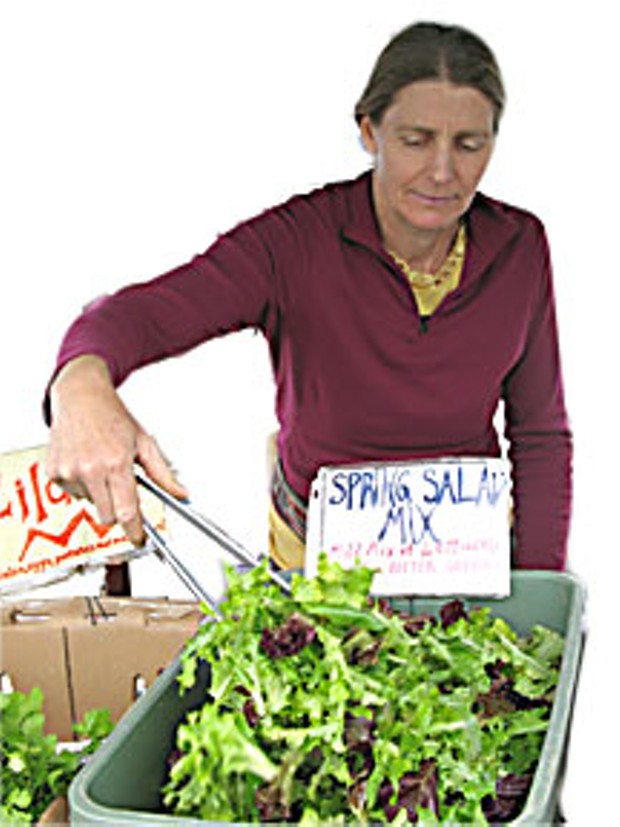[
{
"name": "Top Stories Video Pair",
"insertPoint": "7",
"component": "17087298",
"parentWrapperClass": "fdn-ads-inline-content-block",
"requiredCountToDisplay": "1"
}
]
With the Farmers' Market now in full glory, the North Coast community is blessed. How can we make the most of this bounty?
When we opened our restaurant, Byrd House, over two decades ago, people warned us that there were "vegetarians" who would look askance at our omnivorous menu. I did not take them seriously. We had, even in those pre-farmers'-market days, access to a variety of local produce from the Co-op and from local farmers. The Potters' Blue Lake farm was in full swing, as were several places in the Hoopa Valley, and we got deliveries from Marilyn at Seaside Herbs. So I made certain to include an interesting salad, pasta primavera, roasted broccoli with garlic and Parmesan and steamed vegetables with a chive beurre blanc.
Not good enough, said a handful of vegetarians. They wanted more variety, more complex preparations, spinach lasagna, lentil loaf -- concoctions from The Moosewood Cookbook, a collection of amateurish recipes from a "legendary" restaurant in Ithaca, N.Y. Unfortunately, making vegetarian food that offers the range of flavors available from animal fats is a lot of work. Vegetable stocks require intensive cooking and reduction, and still don't come close to the richness of chicken or beef broth. You'd really have to make it a full-time endeavor. So while we had vegetables, we didn't have vegetarian customers.
Too often, in the course of daily meals, vegetables are an afterthought, and indeed, simply serving steamed or sautéed vegetables can make meals dull. For our family, eating more fresh vegetables has been a long-time goal, but one that's difficult to achieve when both people have jobs. There's a limit on how much prep time you want to put into supper after a day's work. So for years we settled on a single seasonal vegetable dish, far short of the recommended two cups a day. And when we had salads, we often didn't finish them -- they were monochromatic, even using various bottled dressings like Annie's. The basic constituents were the same. Boring.
Then last summer I decided to create a process that would give us nightly salads so attractive we would want to eat them. I built the recipe from the French model, using small quantities of the best possible ingredients for the dressing, and adding a variety of "goodies" kept in a special refrigerated Salad Bag. Since then, we eat a large salad almost every evening. It's never the same twice, since it borrows from dozens of good restaurants here and abroad.
The best salads, of course, are in France. The French seem to find a way to turn everything into a salad constituent, particularly with luncheon and pre-entree salades composes. These can vary from a plate of paper-thin mushroom slices in a tarragon vinaigrette, or a bowl of marinated haricots verts, to roasted root vegetables with spinach, garbanzos and goat cheese, and a spectacular preparation we were served one afternoon in Cognac, brioche croutons covered with warm Bleu d'Auvergne over tart greens laced with diced bacon. (The French also serve a simple salad of lightly dressed greens after the main course, called "salade vert.")
Here is a step-by-step method for a French-style salad, built around ingredients from the Farmers' Market and other things available locally. If everything is set up ahead, it is possible to make an irresistible salad for two in just 10 minutes. And make it different every night.
The most important single ingredient is the oil. While we keep half a dozen vegetable oils, the only olive oil as good as the best French ones is Olinda Ridge Master Blend, available at the Co-op in bulk or in 17-oz. bottles at Wildberries for $13. If you three to four times a week, leave the bottle out of the fridge (it will last easily 6-8 weeks unrefrigerated). Do not ever cook with this oil. Beside salads, its rich flavor enhances pasta and bread (instead of butter), and it can be used for sandwiches (in place of mayonnaise). When you first open the bottle, inhale. The Garden of Eden smelled like that.
Next is a good, potent but neutral vinegar. The best we know is Trader Joe's White Balsamic Vinegar. Find a vinegar that is 6 percent acidity (most American ones are watered down to 4 percent). Soler Sherry Vinegar is a decent alternative, and there are red wine vinegars called "balsamic," but beware of bargains. There's usually a reason for low prices.
In a stainless 4-quart mixing bowl combine:
2 t olive oil (unrefrigerated)1/2 t vinegar (unrefrigerated)1/2 t lemon juice (or 1/8 wedge of lemon, squeezed through a strainer)2 pinches sea salt8-12 grinds black pepper
This makes about a tablespoon. It will look like too little dressing. It's not. It's just right. More will make a soggy salad.
Optional dressing additions:
French Dijon mustard (sorry, Grey Poupon is not adequate)Small squeeze from a tube of caper paste, anchovy paste, or tomato pasteLeftover white wine in place of lemon juiceSpanish paprika in place of black pepperClove of garlic, pressedFinely chopped fresh herb, especially tarragon, oregano, basil, mint or chive (choose one)
Using a whisk or fork, mix the ingredients into an emulsion (but I've sometimes forgotten to mix them, and the salad turned out just as good).
Now add a scant handful of sliced, chopped sweet onion (Walla Walla or Maui), and about 1/2 cup of roughly chopped iceberg lettuce. The iceberg is not a big flavor enhancer, but its texture will provide air and prevent the salad from clumping.
Do not toss yet.
At this point we get to the "goodies" -- these are the intriguing little nuggets of flavor and texture that will ensure you don't fill up on meat and bread before eating the salad. I find time to make some of these ahead (for example, I pit dates and pickle pepper slices), but many come ready-made, and need only to be cut and thrown in. The fact that they are all in The Bag means that you don't have to spend a lot of time assembling them.
The thing to remember about goodies is 1) don't overdo them -- they are the frosting, not the cake; and 2) balance the flavors -- you are going to have bites of salad that include everything together, so consider how the ingredients fit each other. For example, chunks of pitted Medjool date are great with Cypress Grove Pee Wee Pyramid cheese, but not with diced tomato.
Goat cheese in 1/2 inch chunks or 1/2 inch slicesTeleme cheeseAged cheddarFresh mozzarella ballsCamembert, Brie or Pyramid, including the rind (All of the cheeses above should be cut in 1/2-inch pieces)Whole or half roasted walnuts or pecansPitted olives (bulk salad bar olives have more intense flavor)Thin slice of prosciutto, capicola or salami, julienned with scissorsLeftover bacon cut in 1/2-inch piecesSweet red, yellow or orange peppers, seeded, blanched and sliced thinlyButton mushrooms (tiny whole, or thin slices)Small tomato, diced (or half cherry tomatoes)Half an avocado, cut into 1/2-inch chunks2-3 kumquats, sliced thin and seededCubes of blanched and chilled root vegetables (carrot, potato, fennel, beet)Thinly sliced Armenian (or English) cucumber, or baby squashBlanched and chilled haricot verts, snap peas, or green beansCooked garbanzo or cannellini beans, rinsed and driedPeeled ripe fruit, in half-inch chunks (pear and mango are particularly good)Dried fruit, julienned with scissors, or cut in small pieces (apricots, dates)Homemade croutons from leftover Brio bread
Note what this list does not include:
things that are bland or don't add flavor, like tofu, celery, raw nuts, grapesthings that taste raw, like peppers, bean sprouts, raw carrot, cauliflowerthings too small to be forked, like peas, capers, raisins or blueberries
These are not my "rules," they are based on what the French do. You want raw sunflower seeds, alfalfa sprouts and raisins, go ahead. But it won't taste the same.
Do not toss yet.
Now comes the last layer. Add two handfuls of mixed baby greens or spinach. This is where the essence of the salad flavor lives, so a bag of baby greens from the Farmers' Market is ideal, although some local food stores have a bulk greens bin. (A little arugula goes a long way; I use it as an herb rather than a major ingredient.)
No, put away those salad tongs. Get out two salad plates. (Start warm water running.) Using one hand to hold the bowl, and the other to toss, reach into the bowl, and begin gently turning everything. Keep doing this until your touch tells you everything is about equally coated. Then take a big handful from the top and put it on one plate, and do the same with the second. This should be mostly greens and lettuce; the next handful will be mostly additives. In this way, you should be able to divide the ingredients equally, and scrape out the remainders.
Now wash your hands.
Chill both plates for 20 minutes before serving.
Speaking of Food
more from the author
-
In Defense of SPAM – Part II
Is it good for you?
- Aug 26, 2010
-
In Defense of SPAM (Part 1)
A brief history of Hormel's spiced ham loaf
- Aug 19, 2010
-
National Anathema
Is "The Star-Spangled Banner" really who we are?
- Jul 1, 2010
- More »



































